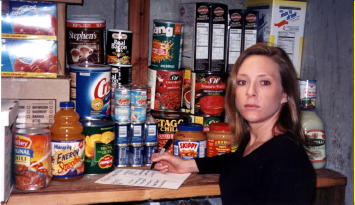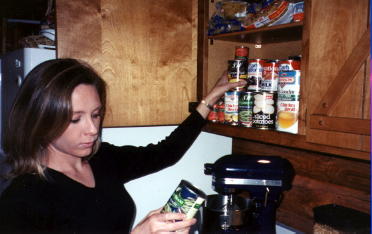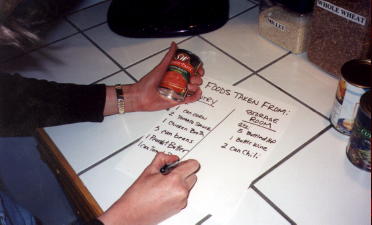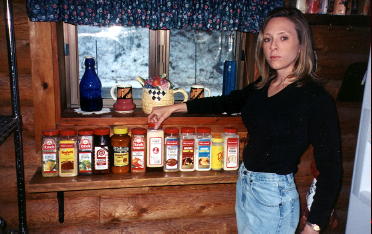HOODS WOODS – Home Survival!
Karen Hood’s – Can the Dependency
Emergency Preparations – Karen Hood’s Article
The following article by Karen appeared in the quarterly magazine "Y2K – Disaster 2000" published by Harris Publications May, 1999. The magazine is now off the shelves but the information is more important now then it was before that potential disaster. We felt that it would be helpful to anyone who needs help deciding how to start preparations for any urban emergency particularly since the events of 9/11 and the developing threat of Bird Flu.
Ron
CAN THE DEPENDENCY
By: Karen Hood
© 1999 Karen Hood
I was in the grocery store the other day and overheard a woman talking to her husband. She said, "I’m concerned about this terrorism thing. I don’t even know where to start. What foods should we get?" I watched them for a little while. They continued down the isle with worried eyes and an empty cart. I continued with my shopping and ran into them a couple isles later. They had a nearly empty cart and they still looked worried. The answer was right in front of them the whole time. Just buy what you normally buy, but buy more of it.
Too many people think that they need to spend thousands of dollars on one- to two-year quantities of freeze-dried foods in order to stock up properly for terrorist alerts. I know that there are a lot of people here in the United States that just don’t have the extra money to spend on these major freeze-dried packages. There are other ways to prepare.
ADVANTAGES OF CANNED vs. DEHYDRATED
Canned goods are less expensive – Canned goods bought in bulk are roughly, pound-per-pound of finished product, about 25% of the cost of the same product offered in freeze-dried or dehydrated form. The canned foods just seem to take up a little more storage area. That’s a small sacrifice when you think about the amount of money you’ll be saving.
Canned goods generally have more calories – It’s difficult to make a direct caloric comparison between freeze-dried/dehydrated foods and canned foods. But it is generally true that canned goods contain more calories in the form of fats than freeze-dried foods. Fat has more calories per ounce than other types of foods so it’s pretty easy to come to the conclusion that canned foods, in general, have more calories pound-per-pound than do freeze-dried foods. Published food values support this contention.
Canned goods already have water for preparation in the can. Freeze-dried/dehydrated foods have no water content. This means that on top of the drinking water you’ll need to store, you will have to store extra water for your food preparation if you have freeze-dried foods.
Other advantages – Canned foods have a good shelf life, they’re available at virtually every market, and you are already familiar with the preparation since these are foods that you eat every day.

STOCKING UP MADE SIMPLE:
Ron and I have a this take on food storage. Our rules are simple and they’ve worked for us.
Buy what you can afford.
Buy what you’re familiar with.
Buy foods on special, from warehouse stores, or from feed and grain supply stores.
Organize your buying for 3-month increments.
Learn to Can
Buy what you can afford. Don’t completely deplete your savings by buying a massive amount of food all at the same time. This could be devastating to your family economy and it’s not necessary. Buy extra food during your normal shopping excursions. Instead of buying one can of corn – buy two and put one in your storage room.
Buy what you’re familiar with. Of course you could buy freeze-dried foods, but what if it isn’t as bad as you are preparing for? You’re going to be stuck with pounds of food that’s different from what you normally eat. A stressful time is not a good time to totally change your diet. If you buy foods you’re already familiar with – you’ll already know how to fix them. Also, if the crisis isn’t as bad as you planned for, then you’ll be able to eat these canned foods as you would on a normal day.
Buy foods from warehouse stores. These stores are great! Purchasing bulk quantities at a reduced price: what resource can be better than that! These warehouse stores are all over the United States and are completely stocked up. They’re especially good for canned goods in bulk, such as rice, beans and seasonings. Make it a point to check your local newspapers for canned foods on sale. Coupons can also help you save money. Feed and grain stores are a great resource too! They carry many inexpensive grains that people normally buy for their farm animals. These grains are the same grains that you’ll need. Any good feed supply store is going to have a great selection of the grains.
Organize your buying for three-month increments. Some folks are buying food quantities for their family for 1-year increments. To make it easier on your wallet and mind, buy enough food for you and your family to last you for three months. When you’ve gathered enough food for you and your family (and pets) for three months, THEN gather another three month’s worth of food and so on. Here’s a simple chart to use as a rough guide for buying your food.
Learn to can – Canning is easy to do and inexpensive.
The list shown is for three months. You should increase your supply in three-month increments. Complete each three-month supply before moving on.
|
Food Item |
Adults |
Children |
Example |
|||
|
3 month supply |
Quantity in Pounds |
Quantity in pounds by age |
Family of four, 2 children ages 4 &9 |
|||
|
Male |
Female |
1-5 |
6-12 |
Total Lbs. needed |
||
|
Canned meats |
5 |
4 |
1 |
2 |
12 |
|
|
Canned margarine, powdered eggs etc…. |
2 |
2 |
1 |
2 |
7 |
|
|
Dried beans, peas, lentils, etc, |
6 |
5 |
2 |
4 |
17 |
|
|
Dried fruit juice and concentrates |
6 |
5 |
5 |
6 |
22 |
|
|
Dried fruits (dried, equal to this fresh weight) |
25 |
25 |
20 |
20 |
90 |
|
|
Gelatin, Jell-O, tapioca, instant pudding |
3 |
2 |
2 |
2 |
9 |
|
|
Grains, rice, oats, millet etc. |
25 |
20 |
15 |
20 |
80 |
|
|
Non Fat dried Milk |
25 |
20 |
30 |
30 |
105 |
|
|
Peanut butter |
3 |
3 |
4 |
4 |
14 |
|
|
Potatoes (dried, equal to this fresh weight) |
12 |
12 |
8 |
12 |
44 |
|
|
Salt |
2 |
2 |
2 |
2 |
8 |
|
|
Shortening oils |
8 |
6 |
6 |
7 |
27 |
|
|
Sugar Honey |
12 |
8 |
4 |
6 |
30 |
|
|
Variety of vegetables dried, (equal to this fresh weight) |
9 |
8 |
6 |
8 |
31 |
|
|
Wheat |
75 |
50 |
25 |
50 |
200 |
|
|
Total |
696 |
|||||
**Recommended Dietary Caloric Intake from USDA
SUPERMARKET SUBSTITUTES FOR ITEMS ON THE ABOVE CHART:
Most of the items on this above list are self-explanatory. There are a few points I’d like to bring up about some of the items listed though.
Canned meats could be any type of meat. Get a variety. The notorious canned Spam, for instance, is a good source of meat/protein and it stores well (about 5 years). Canned tuna, salmon, chicken, turkey are all good sources of protein. Many times you’ll find free recipe offers on the can. Spam is a great example. If you look on the back of the can, you’ll frequently see a free offer for a cookbook with several recipes that will help you make the most of this canned meat delight. Spend a little time sending in for these free offers. They might help you be creative when hard times arrive.
Canned margarine is harder to find. Margarine in the tub will last a long time even un-refrigerated. It ordinarily separates into its components when it’s not refrigerated. Just mix it up as it separates and try to keep it as cool as possible. Quick tip: Velveeta cheese is an eternal food that stores for a long period of time. Velveeta heated and mixed with a little water and powdered milk makes a reasonable butter substitute.
Shortening Oil is another favorite of mine. I recommend storing olive oil because it stores very well, can be used for baking and as a replacement for butter or margarine. Another good thing is that it can also be used in oil lamps for emergency lighting.
Grains, wheat, and millet are all good to have in storage, but they’ll do you little good if you don’t have a grinder or don’t know how to prepare them. These whole grains are easier to store for longer periods of time than their powdered form (flour). Flour can last about 6-12 mos. in a non-airtight container. If you store it in an airtight container, you’re looking at about 1 ½ -2 year storage. It may be a little stale if you keep it the full 2 years, but it will still be useable. So if you’re not sure how to prepare those grains – just buy flour and store it in airtight containers for emergencies
PANTRY STORAGE:
Now that you’ve purchased your foods – how the heck do you store them? That’s simple too. You’ll need to establish a pantry and food storage area or areas. Store your staple foods such as canned goods, dry beans, rice, and bottled foods in a cool, dry place. The storage temperature is best if it’s between 34 and 70 degrees Fahrenheit.
Get more than one storage area. Because we have limited storage area in our home, we decided to rent a storage space. We rented the smallest and cheapest one nearest our home. This way when we fill up our storage in our home – we can move that food over to the storage facility. We found it’s cheaper to rent a storage facility for a year than it is to buy a few month’s supply of freeze-dried foods.

PRACTICE ROTATING STORAGE AND COPY CANNING
Rotating Storage – Rotating storage is geographically based. In other words, you will need to create a pantry in one area and a separate storage area. The storage area is used to hold the extra supplies you’ll be storing in case of an emergency. All cans and foods that go into rotating storage must be marked with the date of purchase. Here’s how you use it: Assume you’re going to cook a dinner and you look in your pantry for the food item you need. But you do not have it. Write that item down on your shopping list and go to your storage area. Take the item out of your storage area and use it for cooking. If it is not already in your storage area, go back to your shopping list and increase the quantity of the item so you can put that item in storage and in your pantry. This assures you that the items you have in storage are the things that you usually use.

Keep all your shopping lists for at least a month to check to see what items you use the most and the quantities you use. This gives you a good consumption history to work with.
Copy canning – When you shop for your weekly foods, purchase double (or more) of any canned and packaged goods you need. Mark the extras with the date and place them in storage. Each time you buy groceries "double copy" the foods you buy and rotate them in the pantry. Move the oldest dated foods to the pantry and place the newest foods in storage. Little by little you will accumulate a good supply of the foods you purchase and eat everyday.
HOW LONG WILL CANNED FOOD LAST?
Here’s a rough way to figure out about how long your canned foods will last:
Low-Acid canned foods (pH level of 4.5 or lower) – last about 2 – 5 years. This includes canned meat, stews, soups, pasta, potatoes, carrots, peas, pumpkin, etc.
High Acid canned foods (pH level of 4.6 or higher) – last about 1 – 1 ½ years. This includes tomato sauces, fruits, vinegar-based foods, etc. Remember that this is an estimated, recommended shelf life. Some of these foods will still be edible after the recommended storage date, but the foods could have nutrient or quality loss if used after this amount of time. It’s also very important that if the can is bulging, leaking, smells bad or spurts when you open it – THROW IT AWAY! Make sure when you throw it out that you put it in a place that your pets or your kids can not get to it.
Here’s a condensed chart of some basic canned staples to help you figure out about how long some common canned foods last:
Canned FoodShelf Life Recommendations
|
Chicken, turkey, tuna, fish, seafood, meats |
2-5 years or until expiration date on can |
|
Baby Food |
Play it safe – 1 year or until exp. date on can |
|
Tomato sauce |
1 year |
|
Most fruits |
2-5 years |
|
Fruit Juice |
6 mos. – 1 year |
|
Vegetables |
1-2 years |
|
Baked beans |
1-2 years |
|
Spaghetti sauce |
Usually 1 year – use by exp. date |
|
Soups |
Usually 1 year – use by exp. date |
**Remember that your canned food may still be edible if it’s older than the recommended shelf life. The quality and nutrient content tends to deteriorate after this amount of time.
FOOD SPOILAGE:
There are 2 main spoilage factors: Bacterial and Enzymatic.
Botulism is one of the most life-threatening bacteria in canned foods. Botulism toxin is mostly found in home-canned foods. The canned foods you buy from the store, for the most part, are canned under stringent guidelines and proper temperatures. This bacteria forms the spores that create toxins only in the absence of oxygen. These are mostly found in low-acid foods. To avoid being exposed to these bacteria it’s very important that when you open any of your older canned foods, especially home-canned meats, to heat them or boil them for 10-20 minutes before eating them!
Enzymatic spoilage is the natural deterioration of foods. Enzymes, for example, are what make tomato’s get ripe after picking. The enzymes keep working and eventually rot the tomato. These enzymes are relatively harmless and for the most part, their action can be slowed with cool temperatures.
COMMON MISTAKES OF FOOD STORAGE:
It’s easy to make mistakes when preparing for the future. There are so many things to think about. Here are a few common mistakes that people make when planning their food storage program:
Well-Balanced Meals: It’s easy to stock up on a bunch of grains and rice. You can live on this, but it would be better if you had canned meats or canned veggies too. Be sure to store foods that will make your diet balanced.
Too Much of the Same Food: It will be a little boring if you bought a 3 month supply of tuna, beans and rice. I’ll promise you – you’ll want to kill yourself if you have to eat the same thing over and over for 3 months or more. Please make sure you have a variety of foods in your pantry.
Vitamins: Your diet might not be as well balanced if a disaster strikes – so it’s important to keep a stock of vitamins for everyone in your family. Most multivitamins contain more than the recommended RDA’s from the USDA. Vitamins are very important for your body systems to work properly.
Storing your food in one area: If anyone wants to take your food – all they have to do is visit one room and you’re out of luck. Store your food in different locations. That way if someone steals from you – there’s a greater chance that they won’t have found ALL your supplies.
Not enough beer or wine: It’s easy to just think about food when you’re preparing your food storage program. But wouldn’t it be nice to have a glass of wine or beer with that yummy food you’ve stored? My point here is – Don’t forget your beer!! (Remember if you don’t drink, you can use it for barter)
Remember your pet’s needs too. Your furry friends rely on you to feed them. If you’re planning on feeding them just table scraps when the crisis comes – DON’T. There won’t be any. Monitor how much food your pets eat in a given time and prepare for them too. If they have any medications they need – be sure to stock up on them.
Not enough spices: Store spices you’re familiar with. They could make something that’s just barely edible into something that’s very palatable. Get those spices in stock!

Not enough water/ fluids. The average adult person should drink about 7 gallons per week – for drinking purposes only. In addition to this, you’ll need to sock up on water for cooking purposes. The advantage of having canned foods in your pantry is that most of them already have the water needed for cooking. You can store canned soda’s, bottled water, and other beverages of your taste. These store well and for long periods of time. Warehouse stores sell these bottled liquids in bulk. If you do have running water when the disaster strikes; don’t be too sure that it’s clean water. You’ll need to filter that water. Keep a water filter in your supplies as well.
NOW IS THE TIME TO START PREPARING:
Now you know the basics for getting started on your food storage program. I don’t want to completely turn you away from buying any kind of freeze-dried foods. Freeze-dried foods are good to have in your pantry because they can be stored for very long periods of time. They’re great for surprise guests. But it’s always good to keep a copy canning rotation cycle going.
In short… It is time to prepare for any potential disaster approaching us. The process does not need to kill your finances or be unbearably stressful. Neither does it mean that you need to be inconvenienced with foods that you are unfamiliar with and have no other use for should the disaster not materialize. By preparing in the ways I’ve mentioned, you will assure yourself and your family of a reasonable chance for a comfortable transition into the new millennia.
Be sure to get the Woodsmaster and Cave Cooking videos. The information in these videos will help you in many ways and give you the confidence you need to face the new millennium… as well as help support our efforts to bring you new information about survival in all environments and under all conditions
Ron and Karen
Emergency Preparations – Karen Hood’s Article












